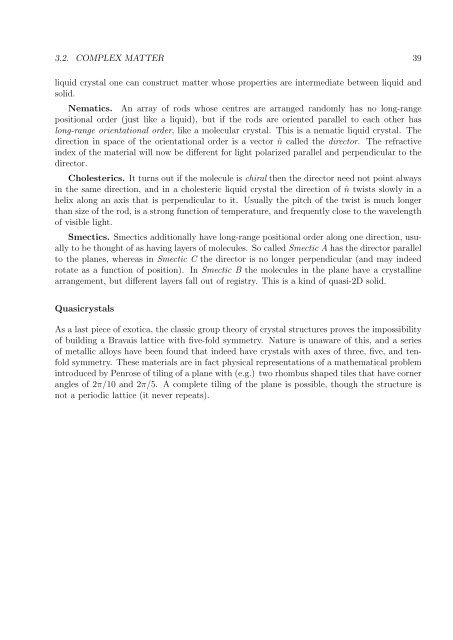Set of supplementary notes.
Set of supplementary notes.
Set of supplementary notes.
Create successful ePaper yourself
Turn your PDF publications into a flip-book with our unique Google optimized e-Paper software.
3.2. COMPLEX MATTER 39<br />
liquid crystal one can construct matter whose properties are intermediate between liquid and<br />
solid.<br />
Nematics. An array <strong>of</strong> rods whose centres are arranged randomly has no long-range<br />
positional order (just like a liquid), but if the rods are oriented parallel to each other has<br />
long-range orientational order, like a molecular crystal. This is a nematic liquid crystal. The<br />
direction in space <strong>of</strong> the orientational order is a vector ˆn called the director. The refractive<br />
index <strong>of</strong> the material will now be different for light polarized parallel and perpendicular to the<br />
director.<br />
Cholesterics. It turns out if the molecule is chiral then the director need not point always<br />
in the same direction, and in a cholesteric liquid crystal the direction <strong>of</strong> ˆn twists slowly in a<br />
helix along an axis that is perpendicular to it. Usually the pitch <strong>of</strong> the twist is much longer<br />
than size <strong>of</strong> the rod, is a strong function <strong>of</strong> temperature, and frequently close to the wavelength<br />
<strong>of</strong> visible light.<br />
Smectics. Smectics additionally have long-range positional order along one direction, usually<br />
to be thought <strong>of</strong> as having layers <strong>of</strong> molecules. So called Smectic A has the director parallel<br />
to the planes, whereas in Smectic C the director is no longer perpendicular (and may indeed<br />
rotate as a function <strong>of</strong> position). In Smectic B the molecules in the plane have a crystalline<br />
arrangement, but different layers fall out <strong>of</strong> registry. This is a kind <strong>of</strong> quasi-2D solid.<br />
Quasicrystals<br />
As a last piece <strong>of</strong> exotica, the classic group theory <strong>of</strong> crystal structures proves the impossibility<br />
<strong>of</strong> building a Bravais lattice with five-fold symmetry. Nature is unaware <strong>of</strong> this, and a series<br />
<strong>of</strong> metallic alloys have been found that indeed have crystals with axes <strong>of</strong> three, five, and tenfold<br />
symmetry. These materials are in fact physical representations <strong>of</strong> a mathematical problem<br />
introduced by Penrose <strong>of</strong> tiling <strong>of</strong> a plane with (e.g.) two rhombus shaped tiles that have corner<br />
angles <strong>of</strong> 2π/10 and 2π/5. A complete tiling <strong>of</strong> the plane is possible, though the structure is<br />
not a periodic lattice (it never repeats).








